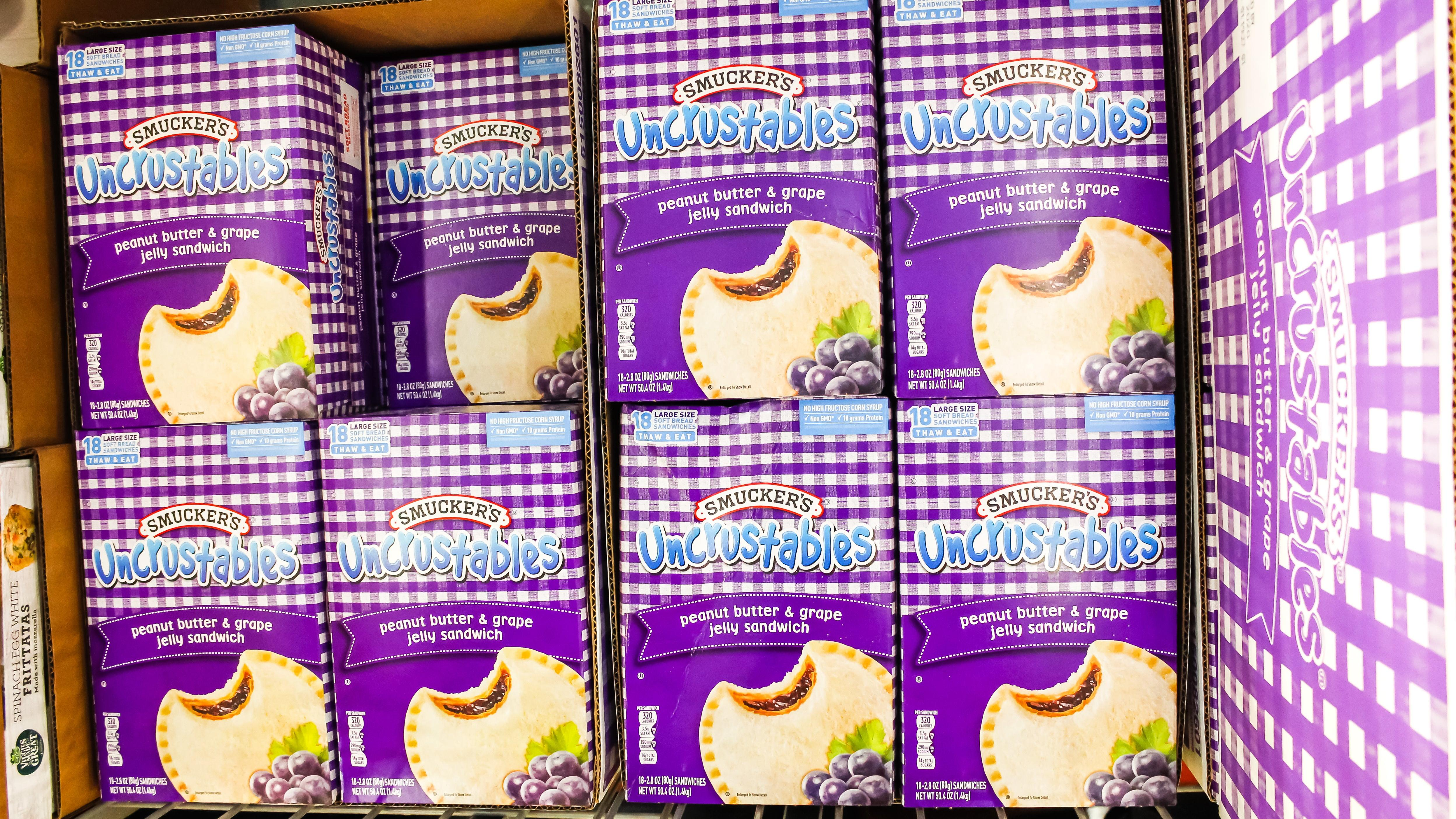What Losing The War On Uncrustables Taught Me About Parenting
Food is food, even when it comes conveniently prepackaged.
We may receive a commission on purchases made from links.
It's easy enough to make my children a PB&J for their lunch every day, and for a long time, I did. I'm not trying to be fancy here: white bread, shelf-stable peanut butter, and some kind of "red" or "purple" jam (strawberry is usually the surest bet). But several months ago, my kids declared they no longer wanted me to make them sandwiches. Instead, they wanted me to buy and pack Uncrustables.
When this proclamation was handed down (after they'd been served Uncrustables on a school field trip), I was distraught, knowing I'd lost an easy meal in my repertoire. I was leery of the dense little pre-wrapped sandwich disks becoming the kids' daily lunch entree. My daughter declared my sandwiches "too crummy," meaning the bread-to-stuff ratio was off. My son liked that he could get an instant hit of food from an Uncrustable whenever he wanted a sandwich instead of waiting a whole two minutes for me to assemble a sandwich "from scratch."
So, I bought a big box of Uncrustables. And I have to admit, packing for lunch really did get easier. Lunch boxes came home empty, and the kids didn't seem so desperately hangry at the end of the day.
Having finally made peace with my loss in the War on Uncrustables—and the war on most packaged food, really—I realize the value in letting children have some autonomy in their food choices and, just as importantly, freedom from judgment about those choices.
The tricky balance of feeding children
I totally understand why kids so often prefer packaged foods to fresh. Dino chicken nuggets always taste the same, and are always shaped like dinosaurs, whereas roasted chicken might have different seasoning or textures from one bite to the next, plus it carries the potential for unwanted surprises like coming across a tendon or bone. I also know how to read nutrition labels and know the guidelines and best practices when it comes to feeding kids. Spoiler alert: Most experts recommend vegetables occasionally.
If you've had an extreme picky eater or a kid with some kind of neurodivergence who only has a few "safe" foods, you know that, at the end of the day, "fed is best." It's a slogan typically used in support of new parents who are learning to feed infants (milk vs. formula, bottle vs. breast, etc.), but it applies to kids at any age.
At one point my pediatrician gave me the go-ahead to serve my daughter chocolate milk at dinner because milk with a little sugar syrup in it is still full of the calcium, vitamin D, and other health benefits of milk, whereas my daughter refusing to drink white milk would mean she gets none of those nutrients at all.
Letting go of school lunch judgment
Since my kids usually prefer bringing their lunches to school, I've had to make peace with prepackaged snack foods that can sit unrefrigerated for several hours. My kids will often have a lunch that includes an Uncrustable, or, if we're going somewhere nut-free, one kid will accept a homemade Sunbutter and jam sandwich on white bread (the other will not). Then I'll provide a large serving of whatever fruit is currently trending with them, plus a cheese stick and/or yogurt tube, and some kind of carb. It's 90% preassembled and way better than nothing. It's not realistic for me to try to be a Pinterest mom every day of my life, with hearts and stars cut out of cucumber slices arranged in a cute plastic bento box, though I have tried.
Since the switch to prepackaged snacks feels like a concession, we can always incorporate some snacks technically made out of vegetables. Carrot sticks and celery sticks are a no-go with my kids, but any number of "veggie stick" products are acceptable to them, such as these Veggie Straws or the Trader Joe's equivalent. For those who seek a variant of the beloved Pirate's Booty, there are all manner of puff snacks available, like cauliflower "stalks" made by Real Food From the Ground Up, butternut squash cinnamon puffs from You Need This, or "upcycled heirloom corn flower" Pipcorn Twists, which have a sea salt flavor my kids like and a cinnamon sugar one that tastes like Taco Bell Cinnamon Twists. My kids will sometimes also accept dry, plain Cheerios, which at least include some measure of soluble fiber.
The bigger picture
After taking a course on intuitive eating and reading the book How to Raise an Intuitive Eater by Sumner Brooks, I began to see that giving kids the lunch they want is part of teaching them body autonomy. I use "want" here loosely. They probably want nothing but chocolate pretzels and Starbursts, but they have learned, with guidance, that they don't feel great if they only eat sugar-based foods. Teaching them to honor their hunger and preferences is part of a bigger picture: It allows kids to form their own identities, not only in the way they relate to food at mealtimes, but also how they live in their bodies and establish their sense of self.
Eating disorders are still a huge problem among children, and placing judgments on food is a big trigger for disordered eating and distorted body image. Chastising kids (and their parents) for eating foods you might call "junk" will do nothing to help them make choices that keep their bodies healthy. So, while I do try to float the idea of revisiting carrot sticks every so often, and create opportunities at home to try new things, I know that my kids are eating a full lunch at school, packaged or not, and are better able to focus on whatever they're learning at school that day, not any lingering hunger or sense of shame.
